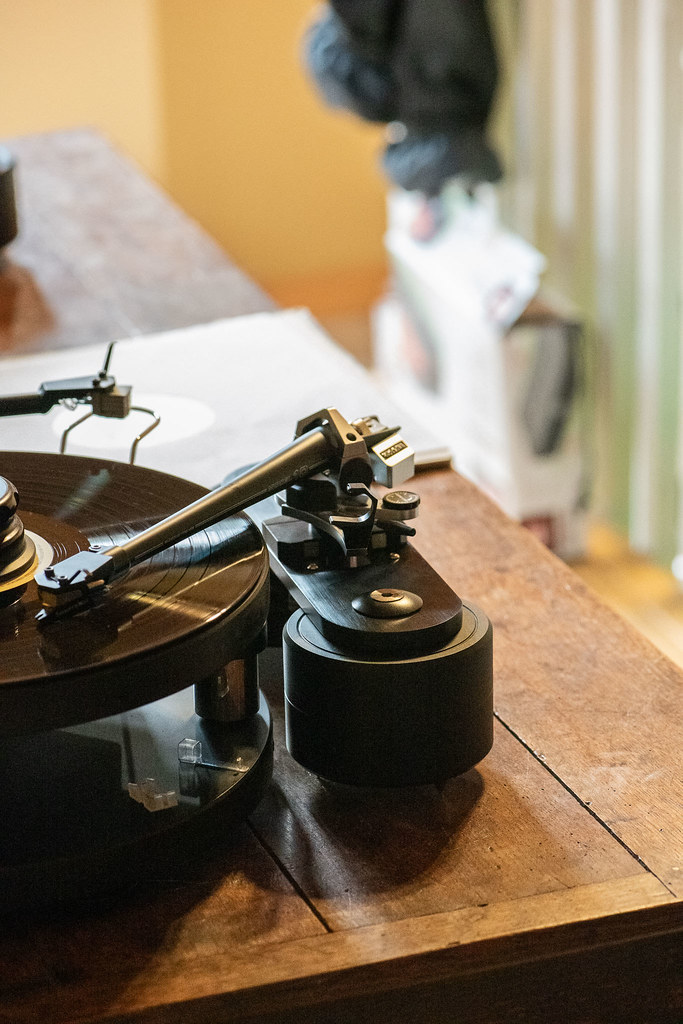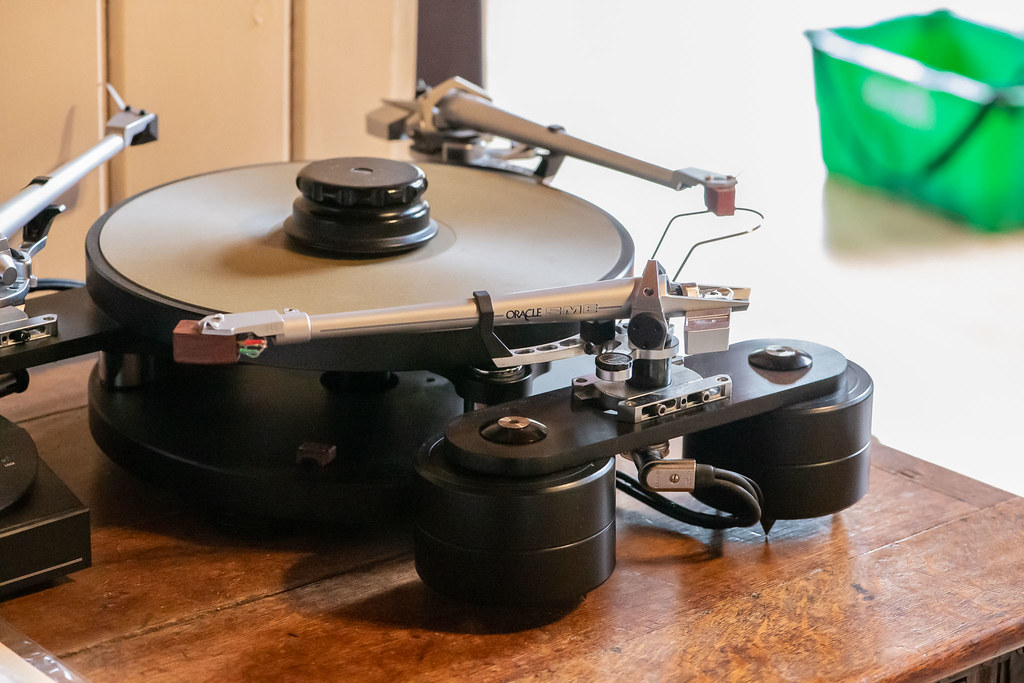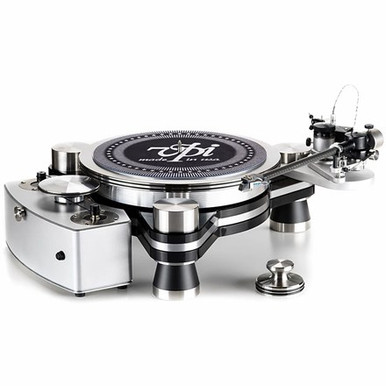As stated previously on this forum, I have produced a TA Standalone Pod design. The intention of the Pod was to aid with an inquisitive mindset, and enable other TA's to be tried out in advance of swapping out the regularly used TA, at a time when I was suspecting a improvement could be found from an alternate TA. Theories never realised, I discovered my new TA through a different course.
I totally am on board with the use of a Standalone Pod to enable reasonably easy to achieve extended experiences, a lot worse has been done to achieve this.
As stated, I am regularly experiencing a Standalone Tonearm Pod in use with a Glanz MH12 and SP10 R. I can't detect any sonic that is seemingly unattractive as result of the Pod being used.
As stated previously on this forum, for a TT > TA Interface, I lean heavily towards the philosophy of using the rigidly coupled design. In the earliest days of developing and interest in using TT's and the importance of the mechanical interfaces, I become a little obsessed with the trueness of rotation of a Platter Spindle and this evolved into my interest in the stability of inherent properties for a Plinth material.
I will assume the Plinth material interest was stimulated by the big name Manufacturers usage of resin composites as a Plinth, and how some smaller artisan entities with an interest in TT's moved on to resin composites and Natural Stone. I recollect on occasions being in discussions with the artisans about the use of Natural Stone over the usage of Stone Composite.
In the early 90's I moved on from the usual type Plinths and commenced using materials that I had come to understand (rightly or wrongly) as a very stable in its properties material for the use as a Plinth.
From the early 90's I have used Granite, this evolved and I moved on to Corian, and also purchased a quantity of Slate, a Metal Material never really got my interest. Stone Type material has been in use as the main material of interest until approx' 2015.
In 2015, I commenced meeting (face to face) with, Plinth Builders known for their work undertaken with the Polybentonite Resin. I was looking at this as an upgrade material, to become adopted and used in the place of Corian.
Whilst learning about the properties of Poly' Resin, especially the Damping / Dissipation properties having a desirable measurement, when adopted for use as a massy Plinth, with the intention of being used in place of Stone or Stone Composites. It was at this same time I was also made aware of material such as Panzerholz and Permali.
I was soon to learn both P'holz and P'mali were becoming sought after materials to be used for a Plinth. I set out to become very familiar with these products manufacture methods ( Phenolic Resin Impregnated Densified Wood).
Additionally through other parties, I learnt how certain tested densified wood material has properties that are very stable and in relation of the Intrinsic Damping / Dissipation are very well suited for usage in audio.
One don't have to look to far today to see how Phenolic Resin Impregnated Densified Woods are in use in audio. As made known recently, Linn has also now adopted the use densified wood in their TOTR £60K TT, it is most likely from the Brand Panzerholz? It is not uncommon to see this Brand in use, where the Company using it for audio purposes has given it a 'in house' name.
I am keen on / an advocate of rigid coupling the TT Spindle > TA Pillar when the material used to anchor the Chassis/ Platter Spindle and Tonearm are with intrinsic properties that prove them as being very stable. To have a material option that also has intrinsic properties that are attractive for Damping/Dissipation of energies being transferred is also a big bonus, when considering rigid coupling.
Over the years I have seen soak tests for high quality Board Materials, the types that one would want to see used in a wood used for a good quality Plinth. I have also looked into substantially increased in compression boards where the Kg per m3 close to a 1000Kg per m3, not the typical 650-750Kg per m3. If I have read the data correct these board types have substantial increase in dimensions when compared to a board type such a Phenolic Resin Impregnated Densified Wood.
Typical Boards are designed for a particular function and meet the parameters of the design requirements and will last for a particular period of function if used correctly.
Resin Impregnated Densified Wood is certainly not designed as a Plinth material, but does have intrinsic properties that lean towards it being a attractive option.
I am not suggesting in any way that materials such as P'holz or P'mali are the ideal material for all to use, the influence on the sonic produced may not be attractive to many who encounter the material in use. I am yet to meet somebody who has been demo'd a P'holz Plinth as a comparison to a alternative board material using the same model TT > Tonearm > Cart', that has not resulted in the individual rejecting the P'holz, I only know of individuals adopting the usage of the Resin Impregnated Densified Wood.
I am trying to get across is Typical Boards or Woods selected for Plinth designs that are based on rigid coupling are not ideally stable. The Boards or Wood are reactive to the environment. The designs in place allow moisture to penetrate, which will be a cause of expansion and shrinkage.
There are other board materials used for Plinth design that getting data on is quite difficult, but through knowing the materials and seeing it in use as a daily used material regularly, will show that after periods of exposure to moisture, it can be sponge like, expanding to the point of destruction, where particulate has become detached from the solid.
A rigid coupling philosophy over looks in general the importance of the material selected to anchor the parts to.
I would be quite confident using a TA mounted directly over a Standalone Pod in conjunction with a TT, when each has the TA and Spindle anchored to a materials that has very stable properties. I also would be even more confident in using thios method if both Standalone Pod and TT were mounted on a single Sub- Plinth that was produced form a material that has very stable properties, as this would ensure the best of set up methods are in place to attempt to ensure critical geometries and dimensions are maintained.
The anti-thesis is to mount both TT Spindle (Bearing Housing) or TT Chassis and Spindle with the TA onto a material that expands and contracts. This method strongly suggests critical geometries and dimensions are in constant fluctuation.
Individuals expressing an interest in the rigid coupling philosophy if in ownership of a TT that has this used as the method, will be in a very good position to see if theirs is a design that utilised materials to be anchored to that have very stable properties.
As somebody with long history of expressing a keen interest in mechanical interfaces and the maintenance of the dimensions used for the geometries being used, the rigid coupling method has been discovered to have many sides to it that are worthy of raising concerns.
Some of the designs known of, would easily be replaced as a betterment using the suggestion for mounting a Standalone Pod referred to earlier.
Not to be overlooked, for the record, listening and enjoying the entertainment is the goal. All methods employed to interface a TT and Tonearm are quite capable of replaying recorded music to a level that is able to be thoroughly enjoyed by multiples of listeners, I am one of these myself.







![[IMG]](https://live.staticflickr.com/65535/53647641058_440121052e_b.jpg)

